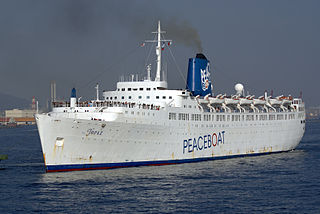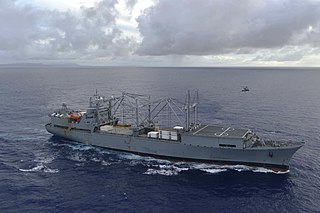Related Research Articles

Marine Atlantic Inc. is an independent Canadian federal Crown corporation which is mandated to operate ferry services between the provinces of Newfoundland and Labrador and Nova Scotia.

RMS Empress of Britain was a transatlantic ocean liner built by Fairfield Shipbuilding at Govan on the Clyde in Scotland in 1955-1956 for Canadian Pacific Steamships (CP). This ship — the third of three CP vessels to be named Empress of Britain — regularly traversed the trans-Atlantic route between Canada and Europe until 1964, completing 123 voyages under the Canadian Pacific flag.
Four ships of the White Star Line have been named SS Belgic:

USS Vinton was a Tolland-class attack cargo ship in service with the United States Navy from 1945 to 1946. She was sold into commercial service and was scrapped in 1971.
SS William R. Cox may refer to one of three American Liberty ships named in honor of Civil War General William Ruffin Cox:

The SS Empire Miniver was a British steam merchant ship. She was originally an American merchant, launched in 1918 as SS West Cobalt. During a brief stint in the United States Navy in 1919, she was known as USS West Cobalt (ID-3836).
Stephenson Clarke Shipping Limited, established in 1730 is Great Britain's oldest shipping company. The company specializes in short sea bulk cargo such as aggregates, alumina, grain, coal, fertilizers and steel.

SS Prinz Friedrich Wilhelm was an ocean liner for North German Lloyd (NDL) from her launch in 1907 until the end of World War I. After the war, she briefly served as USS Prinz Friedrich Wilhelm (ID-4063) for the United States Navy returning American troops from France. The vessel was first chartered—and later purchased outright—by Canadian Pacific Steamships (CP) and operated under the names Empress of China, Empress of India, Montlaurier, Monteith, and Montnairn. She was scrapped in 1929.
Lykes Bros. Steamship Co., also called Lykes Lines, was a cargo shipping company acting from the beginning of the 20th century to 2005 having its main business in the trade to and from the United States.

The Type C4-class ship were the largest cargo ships built by the United States Maritime Commission (MARCOM) during World War II. The design was originally developed for the American-Hawaiian Lines in 1941, but in late 1941 the plans were taken over by the MARCOM.
SS President Grant may refer to the following ships:
SS Louise Lykes may refer to one of the following ships built for the United States Maritime Commission (USMC):
SS Sea Panther may refer to one of several Type C3 ships built for the United States Maritime Commission:
SS Sea Hound may refer to one of several Type C3 ships built for the United States Maritime Commission:
Cornish City was the name of five ships operated by Sir W R Smith & Sons Ltd.
Almeria Lykes was a 7,773 GRT Type C3 cargo ship that was built in 1940 by Federal Shipbuilding and Drydock Company, Kearny, New Jersey for the Lykes Brother Steamship Co. She was transferred to the Ministry of War Transport (MoWT) and renamed Empire Condor. In 1942, she was transferred to the United States Maritime Commission (USMC) and renamed Almeria Lykes. She was torpedoed by Axis motor torpedo boats on 13 August 1942 and later scuttled.
SS Gracechurch was a UK 4,318 GRT cargo ship built by William Doxford & Sons at Pallion on Wearside in 1930. She twice changed owners and names, becoming SS Peebles in 1933 and SS Mill Hill in 1936. She was sunk by a German submarine in August 1940.

The Type C5 ship is a United States Maritime Administration (MARAD) designation for World War II breakbulk cargo and later a container ship for containerization shipments. The first type C5-class ship was a class of ships constructed and produced in the United States during World War II. The World War II C5-class ship was dry bulk cargo ship built by Bethlehem Steel in Sparrows Point, Maryland. Bethlehem Steel built eight ships in this bulk cargo class and four orders were canceled. The C5-class ship has a 24,250 DWT and was 560 feet (170 m) long. The C5 was mainly used as iron ore carriers. The C5 was needed to replace other ships that sank during World War II. First in her class was SS Venore, USMC #1982, delivered on 20 July 1945. The Type C5-class ship designed to fill the need to move iron ore from Santa Cruz, Chile, to Sparrows Point, Maryland, through the Panama Canal, a round-trip of 8,700 nautical miles . Post World War II, four ships were given C5 class type C5-S-78a, these were roll-on/roll-off container ship built by Ingalls Shipbuilding, Inc. of Pascagoula, Mississippi and operated by the Moore-McCormack Lines. The C5-S-78a had a deadweight tonnage of 16,000 tons.
References
- ↑ "Almeria Lykes – Houston, Texas, United States". Archived from the original on 2011-06-05. Retrieved 2012-03-02.
- ↑ "APL: History - 1952-69 Vessel Statistics". Archived from the original on 2011-09-27. Retrieved 2011-08-06.